View current page
...more recent posts

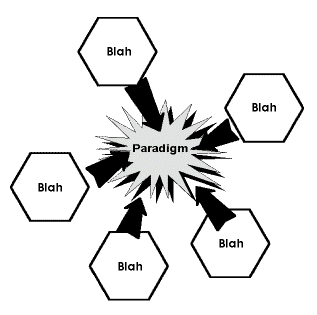
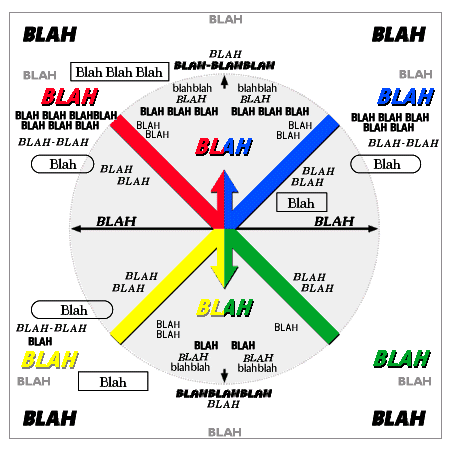
As promised, more GIFs from the mysterious http://castlezzt.net (caution: massive page load).
I hear the second night of "Low Level Allstars" (Thursday Feb 24) at Deitch was better than Wednesday, the night I attended [or I should say even better, since Wednesday was great]. I'm told the sound guy improved (I can attest that he did a not-so-good job the first night), and the speakers were put on tall stands. Also the crowd was bigger and more polite, although according to one report people were sitting down during Bodenstandig, which was definitely an up on your feet partying kind of thing. It's hard to find the right balance between sitting, listening, and partying, especially when trying to manage a typical New York gallery audience of people there to make the scene, yak, and network for their all-important careers.
For an example of what I'm talking about, check out the .mp3 of this John Parker/jenghizkhan performance at the Front Room in Brooklyn. He's playing some great gritty electro-noise stuff and you can hear the schmoozers just schmoozing away. This is no comment on his music--it doesn't matter who's playing here, music and performance are just a sort of background for everyone's personal movie. As I've mentioned before, this is partly because New York has an embarrassment of riches relative to other scenes and people are just blase, but there is also a high oink factor.
In the comments to my second post on Bodenstandig, Jonathan Brodsky floats the theory that jungle (the older, purer version of drum and bass) was the product of open source software, as opposed to musicians using commercial products. Let's nip that meme right here! Here's Brodsky's comment:
I don't know about jungle originating in commercial software environs... It was my understanding that the form developed in trackers similar to the ones that bodenstandig uses, on the amiga. I know that the breakcore sound is mostly due to the tracker interface as well. which software were you thinking was the one that spawned jungle?I clarified that by "commercial software environment" I also mean to include software in so-called hardware synths and samplers, and further replied:
Rob Playford initially used a shareware sequencer called Superconductor (running on an Atari) along with an Akai S-950 sampler and DAT, around the time of 2 Bad Mice's "Waremouse." By 1993 he'd switched to C-Lab's Notator, a commercial product. (C-Lab eventually became Emagic, maker of the popular sequencer Logic.) The real breakthrough for jungle came not so much with tracking, or sequencing, as abuse of (commercial) samplers. From The Mix (1996): "[Metalheadz'] 'Terminator' tore through the scene [in '93] with a vengeance ... its manipulation of timestretching from a sampling utility into a revolutionary new sound effect (by pushing the circuitry way beyond its parameters) made 'Terminator' not just a big tune, but a seminal one for the emerging and, by this time, identifiable new scene."
Bodenstandig 2000, who performed this week at Deitch, bring terrific entertainment value to the greater but potentially somewhat boring cause of open-source, command-line principles. Combining acapella singing, furious real time keyboard playing, spastic, ironic Prodigy-style dance moves and a razor sharp ear for the nuances of various hard-pumping electronic dance genres (if only to proudly translate them into 8-bit, that is, lo fi, "chiptunes"), the duo repeatedly bowled over the audience Wednesday night. Their simultaneous video-projection of a defiantly non-graphic sequencer interface reminds you that the music you're hearing is a steady stream of numbers.
Dedication to old gear and pure hacking vis a vis current proprietary software systems in some ways recalls the rock purists of yore who insisted that only black Delta blues musicians had integrity vis a vis British cover bands, or that 3-chord garage bands always had the edge over prog rock & fusion [was it really necessary to throw out the baby of Canterbury and electric Miles with the bilge of Kansas and Spyro Gyra?]. This kind of essentialism has Occam's razor logic on its side but can also grow stuffy and cult-like. Bodenstandig aren't stuffy, they're funny as hell, but their website(s) are defiantly retro with all-black screens, a simulated UNIX interface, and occasional hectoring about nerdy things like the "right" way to resize images.
Their music and live show present the clearest, most hilarious, most persuasive argument for the absolutist position, but there are other positions. Instead of braving the minefield of newer musicmaking software with all its copyright limitations, commercial agendas, hidden manipulations of the artist, and potential for quickly dating cheesiness, they hold the line for older, more clearly articulated concepts of integrity. This means either no change, or that music must backtrack and take the road not taken, into a parallel universe where there is no Microsoft, no Apple, and all musicians know code.
In defense of commercial software, the communities that develop around a particular bit of gear or program (e.g., Emagic, Native Instruments) apply open-source tenets in the form of forums and message boards where the software developers get ideas and criticisms from users, and then modify products in the next version. This isn't just corporations faking the Linux model; the rethinking process is ongoing and happens at internet speed. Ultimately chores of creation and fabrication are apportioned to the people who do each best, as opposed to demanding that every creator be both artist and scientist. Also, much of the music that Bodenstandig so adeptly imitates (especially jungle) originated in a commercial software environment, often through undiscovered uses or misuse of products by musicians. Truly original, innately 8-bit music would probably take years to assimilate and would not necessarily please crowds.
UPDATE: One point of clarification: by "commercial software environment" I also mean to include the software in so-called hardware synths and samplers. For further discussion and clarification, please see the comments and later posts.















These need to be in synch to look their best (i.e., not viewed in Safari). Single .GIF from the mysterious http://castlezzt.net (caution: massive page load) via mbs. More excerpts to come.
Ridiculously dark photos from "Low Level Allstars," a performance night at Jeffrey Deitch curated by Cory Arcangel and Radical Software Group, highlighting demoscene graphics and new music made with old computers. Below: crowd pleasers Bodenstandig 2000, from Germany, with their beautiful, all numerical MusicMon interface in the background. The sounds they wring out of three square wave generators and practically no memory-load relative to current music simply bugger the mind. Their 8-bit drum and bass number would have had any club audience in the world screaming "rewind!" A mock rock video featuring Bernhard Kirsch (right) zipping through city streets on his scooter (you had to be there) also drew shouts of adulation. (Update: from his website it appears he designs these scooters and this was a promotional video? Sorry, my German is nonexistent.)
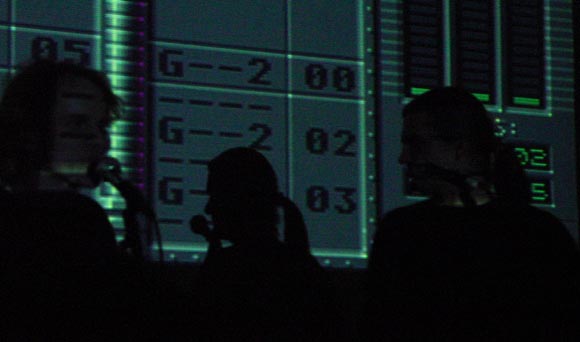
Performing earlier were Nullsleep of the 8bitpeoples crew, who specializes in that tuneless Gameboy stuff Malcolm McLaren likes, followed by Tree Wave (below), previously discussed here. Excellent drone-rock, as in John Cale, Faust, Kevin Shields, all done with Ataris and other vintage computers, and a hacked dot matrix printer. Lauren Gray's vocals work best when woven into the restricted tonal range of the music, as on "Sleep," a song as haunting live as on CD. The more expressive she is the more incongruous. On their cover of Eno's "Needles in the Camel's Eye" she almost sounded like a country singer--which turned out to be a very odd and good choice, though. The song should always be done that way!

The event included artists' talks and some fairly subtle music but the audience topped the charts for rudeness, issuing a stream of loud chitchat that didn't stop the entire night. Maybe it was the cases of free Red Stripe, or possibly the same swine that invaded vertexList a few months back moved to Deitch en masse. I mean, boogeying during Bodenstandig doesn't offend but there's a time to stand still (or sit) and shut up: like, when there are people on the stage talking into microphones. The worst club in Baltimore wouldn't treat performers this poorly. Art poseurs and moronic Deitch scenesters, kiss my ass! Okay, I feel better.
A final note: you can catch the same lineup of performers again tonight (Thursday) from 7 -10 pm. Also in photos: Dragan Espenschied (top photo, left); Paul Slocum (bottom photo, right). More thoughts on Bodenstandig here, here, and here.


"Strychnine Express" [mp3 removed] (my acid techno track; strychnine molecule from google images)






























Audio Sketchbook
"Demo Primeval" [mp3 removed]
"Mr. Arkadin" (Club Mix) [mp3 removed]
"Apres-Midi" [mp3 removed]
"Apres-Midi (Clicks)" [mp3 removed]
"Desultory Arcade" [mp3 removed]
"Reel for Omniverters (Baroque)" [mp3 removed]
"Fangasia" [mp3 removed]
"Bass Iterator" [mp3 removed]
"Demo Primeval" is a mashup of demo samples for two products: the Beatburner and the Mutator, with some gratuitous metalizing added. Some of the tunes are MIDI drum files downloaded off the Net and used to trigger regular, tonal notes in a synth or sampler. A couple of tracks are reworkings of older tunes using better instruments. "Bass Iterator" is the sampler pretty much playing itself: all that dramatic stereo panning just started happening. I call this a sketchbook but these are all finished, if fairly modest, pieces.
Delirious Hong Kong: Check out Michael Wolf's photos of architecture there. Please tell me these are photoshopped:






(another hat tip to Lorenzo Bustillos)
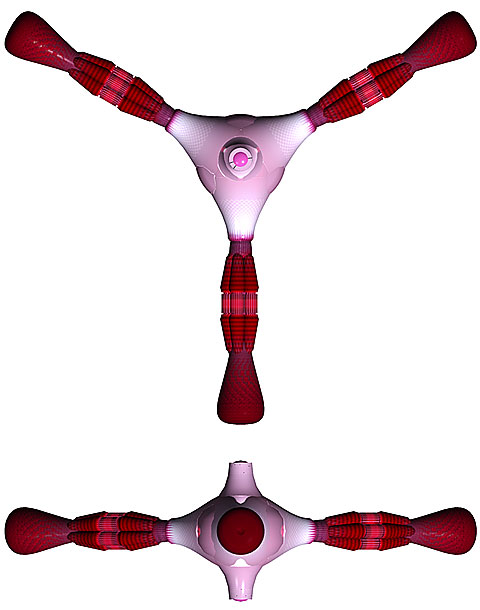

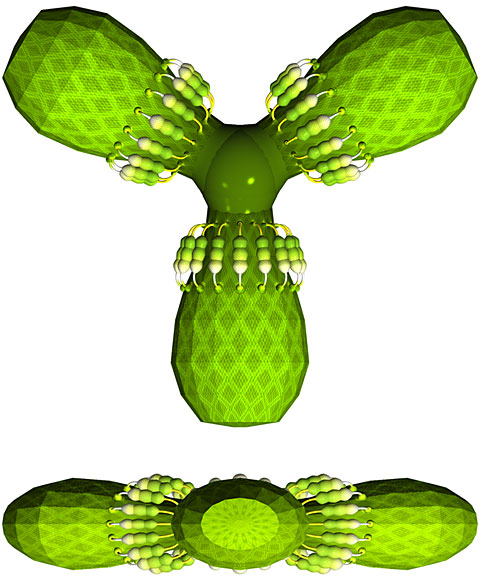
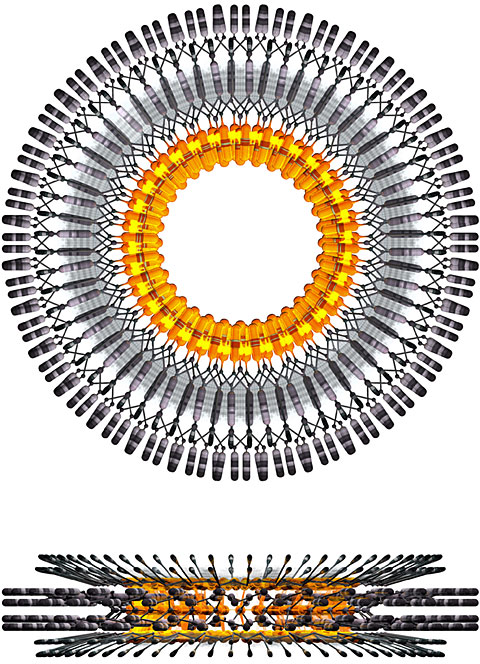

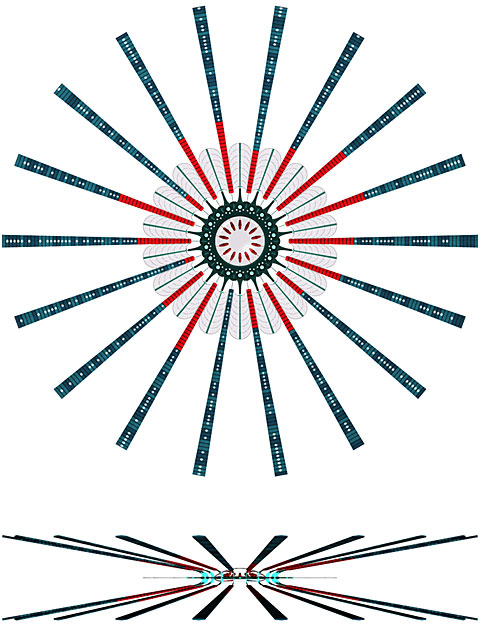
Images from the spacebloom website, teaser for a high concept book about imaginary space flora. I'm not that into the somewhat giddy narrative side of it ("The fbloom prototype consisted of four solpans, two alseco betteries, a conventional emag propulsion unit, and a UPU, all of which were mounted around a tubular frame that housed the centrepiece: the unimbler-based matter processor"), and prefer these elegantly designed computer images against a white background to seeing them superimposed against starscapes. So I guess this is another minimalist remix. (Hat tip to Lorenzo Bustillos)


Noah Lyon reports:
"Someone sent me these pics just this morning. I had given a couple of these stickers to one of Christo's installation crew members a few months ago. He was a German fellow that I happened to sit next to on a flight to Paris. I even suggested he give one to Christo. So maybe this was an inside job (?)Jeanne-Claude will find that crew member and rip his lungs out for spoiling the "feeling" and "their aesthetic." Besides, we don't want to think about war now. We want to think happy thoughts.
UPDATE: These photos give you a good sense of how oppressively low the nylon curtains are, so that when you're walking through them you feel like you're in a subway tunnel. (You also get a good view of the clunky, provisional "feet" they're standing on.) A New Yorker posting on Sally McKay's page waxes eloquent that the gates opened his eyes to the beauty of the park, but I maintain that beauty is always there. Quite the opposite of being outward-looking, the gates hem you in when you're walking through them--they momentarily frame your experience as something cold, mass-produced, and corporate, eclipsing the subtleties of the surrounding natural environment. I believe they are hegemonic and unconsciously hostile, manifesting the relentless desire for power of the rich but frustrated Jeanne-Claude and her dated, captive husband.

mbs asked about the rave video stills (here and here, and thanks to Maciej for reBlogging them). Studio !K7 marketed the X-MIX tapes as veejay tools, I'm guessing, as well as for home consumption. Not all of the ones I photographed are !K7--for a while I was collecting "home trip tapes" so there are others sprinkled in--but the X-MIX vids are indisputably the most creative. They started out fairly primitive (visually) in the early 90s and as the label got more established as a techno hub they grew more elaborate. The computer videos augment what are basically mixtapes by famous DJs. An audio track crossfades into another track and an accompanying visual also fades. Each vid goes with a particular song and they don't recur elsewhere in the mix.
As I mentioned, some of it's cheesy and some brilliant. The level of technology closely tracks the movement from flatness to realistic rendering in the gaming world--I suspect the (mostly European) video producers worked in both worlds. So one finds much wireframe modeling--bugs, babes, robots--mixed in with shimmery, vertiginous psychedelic effects. And cartoon characters with glowsticks and pacifiers. The best vids are the most layered: where you sense the artist trying to work like a drum and bass musician, really mixing stuff up. If only more computer art was this conscientiously mashed up and wild. SCREENFULL comes close to this sensibility--although jimpunk and Linkoln are more art aware and less about fast-lane club kid sensation.
From my neat, gallery oriented presentation it might look like I'm selling these appropriation photos. That's not really my objective. I'd want to get clearance from the artists and labels before I make a buck off them, so as a practical matter I'd say it's a private project published on the net that puts "art brackets" around works for popular consumption. The photos are pretty dry and "connoisseur-y" compared to the videos.

"Guitar Solo" [4.5 MB .mp4 video]
A lot of nice, very up to date music can be heard on cuechamp's .mp3 blog. I miss his blog-blog, where he always had a knack for finding pop culture new media cross disciplinary post studio post human digital mutant artstuff, but having just the music is good, too. Attuned to the realities of the intellectual property vultures who shape our culture and put us in the poor farm in the name of "protecting the artist," he does the snake eating its tail thing and deletes old mp3s as he adds new ones. So, I just noticed "paul revere 04," by Busta Rhymes and DJ Green Lantern feat. Labba, is about to drop off the list. Go check out this potty mouth drug non-condemning revisitation of the Beastie Boys classic. (Also interesting: Golden Shower's digital electro "New York Groove," Nina Gordon's singer songwriter rendition of "Straight Outta Compton," AC/3p's weird AC DC cover, and assorted other oddities.) Speaking of the Beasties, they were in their heyday around 1987, which this blog (mine, that is) has recently adopted as its foster year--it seems like a good stupid one to keep alive through occasional references, research and in-jokes. Perhaps the most recent date that many of us lived through that suddenly seems really really old. One post has already been done. More will come.
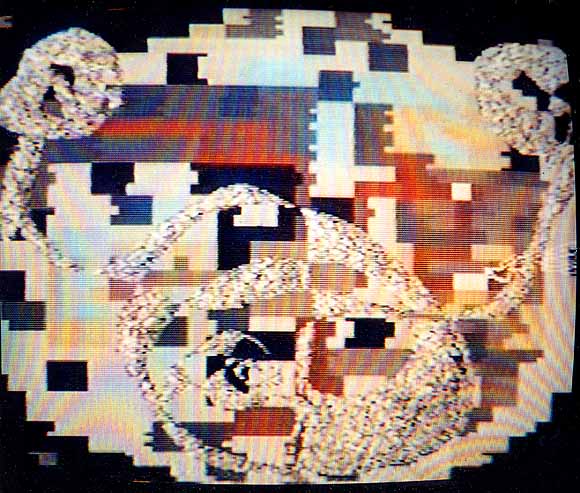
Another detail from what I'm calling the "rave video" stills. This is from Studio !K7's X-MIX series. A lot of cheese in those VHS tapes, since reissued on DVD (not this one though, for some reason) but also some good video/computer/painting hybrid stuff. I mean really good, as in some guy's entire Garbage Pail Kids collection flickering by at several frames per second--and that's just in the background of some other morphy thing or other. The image above was photographed off the TV in pause mode, with a film camera, a few years ago, then scanned; maybe I'll try some stills of the Garbage Pail vid, since I have a digital camera now and don't have to get off my ass to go to the one hour photomat. And no, I will not get a life.
UPDATE: The "morphy thing" was a spinning stop-motion Mr. Potato Head. The collection is 3LUX-2. The artist is either K-OZ or Stalin Retina.

Some impressions of Christo World in Central Park. Walking briskly under the nylon-draped "gates" gives you the feeling you are under a low canopy or awning. The indoor experience of walking through tunnels and hallways morphs strangely with the outdoor experience of walking through open greenery (or brownery, since it's winter now). This is actually not a good thing. Because of the gates' slick fabrication, you feel as if the park had been rented to demonstrate some newfangled, all terrain, corporate convention habitrail system (shades of George Bush's request for a special platform so his feet would never have to touch the dirt of another New York park--Eisenhower, in Nassau County). This might work if the Christos had any sense of irony or self-awareness, but from their interviews they, or at least J-C, the mouthpiece, are tres earnest that it's all about "feeling." Also, the concept of an artificial second layer hovering over the park's rustic walkways fails due to compromises with the Park board. You're walking through an orange tunnel and it suddenly sputters out to accommodate a series of trees that couldn't be trimmed, or abruptly dumps you into one of Olmsted's large open, rock strewn spaces where a bunch of loose gates stand around without any sense of rhythm, solidity, or purpose. The Christos weren't allowed to dig post holes for the gates, and the concrete "feet" that anchor them are an awkward solution. One has to laugh (good naturedly, of course) at the discretely-inserted shims propping them up to adjust for a path's natural slope. But at the end of the day, bad and corporate-looking as the project is, ya gotta say, "damn, they did a lot of work!"
Below is a sculpture by Ross Knight, the "Un-Christo," at the Sculpture Center last year. Knight was allowed to dig into the earth, paradoxically making his work both more ephemeral and more integrated with its surroundings (see link for how all this worked), and his project succeeds, at least in part, because he accepts the modest scale and doesn't succumb to any urges to sit heavily and selfishly on his fellow humans. He also has a sense of humor.
More discussion of the evil Christo and Jeanne-Claude on this ridiculously long (but not ridiculous) thread on Sally McKay's page. Surprisingly many people have stepped forward both here and there to defend the Christos! (This post has been edited slightly.)

rave video stills - details / more details
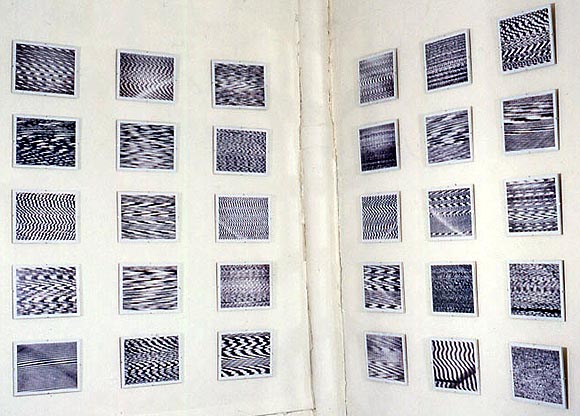
tv static photos (w/ Ray Rapp) - details / more details
One way the Christos' latest work might be successful: If each of those proscenium/gate things placed at regular intervals along Central Park walkways served as an obstacle to movement rather than something you walk through. In other words, if instead of flapping aesthetically over parkgoers' heads, the nylon curtains hanging from the gates were lowered completely, anchored to the ground, forcing people to walk around them or physically rip through them to traverse the park. Thus you would have the pure, condensed hostility of Richard Serra's Tilted Arc, which hampered movement across a public plaza, but with the irony of a bright "joyous" color and billowy nylon fabric. People would be angry, the park would be in turmoil until the piece could be removed, and everyone would be talking about it for years, instead of the Christos getting a mere two weeks of ego-gratification and the big Michael Kimmelman thumbs-up.
UPDATE: The nylon "Gates" swatches selling on eBay originally had some "authorized by the Christos" language that has since been removed, so I took out a parenthetical about the couple selling their wares online. Should have known that was too good to be true. In the comments to this post we're discussing what they're actually going to do with all that fabric.
UPDATE 2: This is one of those rare instances where the kneejerk philistinism of the New York Post converges with the highfalutin' critical opinion (mine--but I'm sure there are others) that the Christos are phony or dumbed down conceptualists. They are really the ultimate middlebrow art. From Andrea Peyser's column:
The artists seemed cute and quirky enough. And the mayor was positively giddy about it. That should have been the kiss of doom.UPDATE 3: Hate to keep harping on those fools in the park, but the Christos' arguable past contribution to the history of art is the extension of conceptual (specifically earthwork) practice to include negotiation and logistics, and navigating local bureaucracies and landowners as art. The running fence itself wasn't very interesting--it was the point of what the artist had to do vis a vis obstinate property rights to make art happen that was a new concept 30 years ago. But to go from all the work Christo did to get the fence built to "convincing Mayor Bloomberg" is just a serious fall from grace.
Now I realize we all were pulled into a kind of mass hysteria orchestrated by a couple of charismatic snake-oil salesmen--also known as the artists Christo and Jeanne-Claude--and their pretentious booster, Mayor Bloomberg.
"The Gates" is an abomination. Call me a Philistine, but how can one improve on trees, lakes and rocky outcroppings with miles of plastic-treated cloth?
It's enough of a sin that "The Gates" overpowers Central Park's soaring, hypnotic beauty. But the color of these bed sheets, plunked down on metal frames every 12 feet throughout the park, is so atrocious that the project's creators ought to be charged with assault.
Christo and Jeanne-Claude claim that the hue of the weirdly pleated cloth is "saffron." But, as any American junior-high-school kid will tell you, the precise shade is "vomit orange."
"I can't get over how much it looks like an advertisement for Home Depot," said a laughing auxiliary cop I ran into.
And he said he actually liked them.
"Jeanne-Claude, your design is good, but it needs color to have impact."
"We've done pink."
"And an incredible pink it was."
"I know........."
"What are you thinking, Christo?"
"It's daring."
"Try me."
"You'll laugh."
"I never laugh at your ideas."
"I'm thinking.....Orange!"
"Orange."
"Yes. Orange."
"My God. But wait...didn't we do orange?"
"Mon cheri, you're right. How could I forget Valley Curtain [Rifle, Colorado 1970-72]? All right, no matter, this time instead of orange we'll call it 'saffron.'"
Updated based on some assiduous Christo scholarship from Dan.
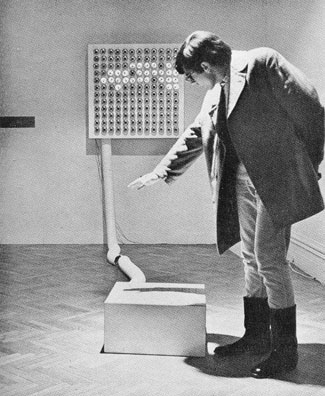
Juan Downey and Fred Pitts, Against Shadows, 1968, plywood, Formica, and electronic parts (photo by Shunk-Kender from Frank J. Malina's Kinetic Art: Theory and Practice, 1974). It's as simple as it looks: a grid of photocells on the formica cube responds to shadows and mimics them in reverse on the wall screen. The klutziness of it (e.g., that huge conduit) is, I believe, intentional. Downey's conceptualist-style statement for the work is still refreshing:
"If the choice were given to me, I would pick complete inaction for my entire life. Nevertheless, I persist in the activity of building electronic sculptures because:
Their existence or destruction is irrelevant to the life of them.Such a contrast with the Whitney's "BitStreams" show, where all the art had to have a purpose, and/or the curator killed it with pedantic overexplanation.
They cause people to play.
They make people aware of the vast number of different kinds of energy in the universe.
They are ephemeral. This is part of a new development in the history of art: to create works that are not supposed to last for a long time.
They pose a problem for the collectors of art objects.
They create the illusion that the public can participate in the work of art. Actually we are still spectators mystified by the order that makes the world grow and move, although, we pretend we are determining what happens to us.
It is fun to talk with friends about them.
They imitate aspects of movement in life. Art is more concerned with thinking about what people experience than with producing objects.
They make people aware of lively relations between different kinds of things.
Children like them.
Sometimes they produce a reversal of natural phenomena, for example, as demonstrated by the sculpture Against Shadows."

MSPaintbrush vs. MSPaint: A Refresher
Some kid out there on the internet mentioned my artwork and told his readers that I "apparently use MSPaint." In context, the "apparently" reads like a slightly disdainful qualifier, as in, "I can't see it myself, and in any case I don't think it's a particularly great use of MSPaint, but that's what the guy says--I'm just telling you." Of course I don't share the ambivalent feelings but do think it's time to trot out an earlier post where I explained the difference between MSPaintbrush (which rules) and MSPaint (which I use occasionally even though it's inferior).
Regarding the orange things going up in Central Park: The collective vanity of "Christo and Jeanne-Claude" is bottomless. Perhaps their only value as artists is exposing and exploiting weaknesses in "the system" that allows projects such as theirs to happen. It would be nice to think they were ironic, and knew the physical art was just fodder for a Hans Haacke-like provocation. No such luck, though.

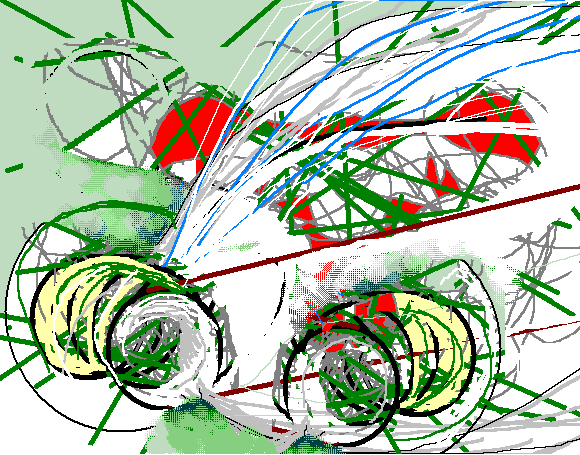
Bug7, MSPaintbrush
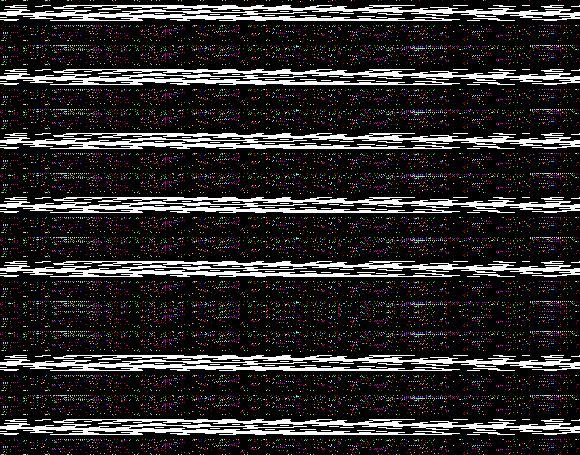
Surge Drawing (Black Stripes), MSPaintbrush

New York Times Ad Model (2002), MSPaintbrush drawing
Too Much Failure Around Here
Inspired by Gary Wicker's tribute to his "failed" old school techno group x-eleven, Paul Slocum of Tree Wave pulled out his tapes of techno music he made in the '90s and posted some tracks here. The following excerpt from "v tide" is one of my favorite bits from the page: [mp3 removed]. Slocum thinks it's "standard minimal house" but not everyone can make a good track. I give it an "A" for the vocal physics (minced Diana Ross) and the organ stab that kind of drops out in the middle like a sampler memory error even though it probably isn't. This is pretty sublime music, and people need to stop talking about stuff being failed. Slightly off topic, Chris Ashley recently shrank a perfectly good, Stephen Westfall-ish HTML drawing with non-contiguous linear elements because he said it was failed and that's just ridiculous. Below: one of Ashley's HTML compositions installed in a virtual gallery.
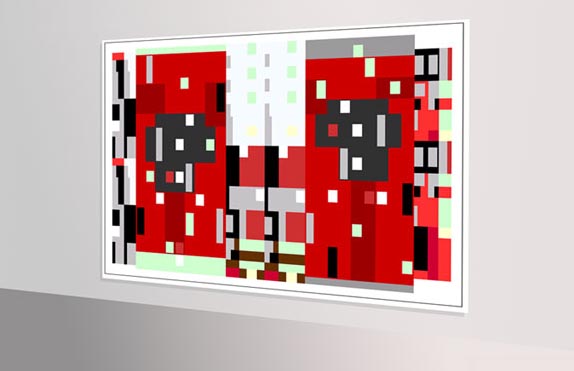
The odious Quiz Show ran on Turner Classic Movies last night. (More on why it's odious below.) During a crucial scene a Congressional investigator played by Rob Morrow (wha' happened to him?) interviews Martin Scorsese as the slimy CEO of Geritol. Normally TCM doesn't bleep dialogue but at the scene's climax the actors' voices started cutting out! "Are you saying that [silence] did [silence]?" "Yes [silence] and then NBC [silence]" is how I remember it. Forgive the paranoia but the movie is about how a little-guy prosecutor went up against Big TV and Big Corporate America in the '50s and lost big. The truth supposedly didn't finally come out till '94 when the brave Robert Redford exposed it--is someone sweeping something back under the rug?
The movie is odious because it's Richard Goodwin's cheap revenge. Goodwin is the prosecutor Morrow plays; he also co-produced the film. In real life he had no evidence that NBC bigwigs paid off a quiz show contestant not to blab that the show was rigged. He couldn't legally tie the top brass to the corruption, so 40 years later he has hugely influential movie star and hack director Redford invent a scene where NBC's president asks the contestant to lie (Redford also significantly enlarged Goodwin's role in the investigation, apparently). The movie exudes smug righteousness but of course it's just one arm of the mediatainment monopoly pretending to police the others. "Look at us, we used to be a cesspool but now we're not!"
The direction and high production values suck you in and keep you watching; too bad Redford doesn't trust the audience to interpret what's going on. He packs the mise en scene with reaction shots of Morrow's boyishly handsome face looking skeptical, disappointed, mad--closeup after closeup as the story unfolds. Ron Howard does this too in his movies, and it's just infantile. I know it's the TV influence, but yuck. Also, speaking of Scorsese, The Aviator features a "sitting around the dinner table with pretentious, eccentric old-money Connecticut WASPs" scene almost identical to the one in this movie.
Stephen Malinowski has posted streaming vids of his Music Animation Machine, a program he developed independently in the '80s using DOS while the music and graphic worlds changed all around him. Fans of Oskar Fischinger, the pioneer, art Deco music animator hired and fired for Disney's Fantasia, and Edward Tufte, the design guru who stresses clean, logical presentation of visual information, should both be impressed by this project. Compositions by Bach, Beethoven, etc. slowly scroll left to right in a notation that looks like a MIDI editing grid, reduced to a range of basic colors against a black field. Malinowksi highlights the parts playing in the present in the center of the field, so the eye can easily follow all the melody lines.
 The project is intended to give the viewer an intuitive sense of what's happening in music, ostensibly for educational purposes, but the scrolls are also artworks on the synesthetic frontier, tickling those synapses where musical and visual pleasure responses precisely overlap.
Only one of the videos posted is Malinowski's own music, and it hints at creative possibilities for his medium beyond just animating the old masters. Somewhere to the right of the screen shot here a dense Lego-like clump scrolls by for just about as long as the ear wants to hear pure Lego, before returning to the tonal main theme. The deliberate push-pull between melody and abstraction, and between audial and ocular expectations, is territory that ought to be explored more. (Hat tip for the link to Cory Arcangel, whose own work deals with similar issues on an aggressive, cinematic scale, and with electro instead of Beethoven.)
The project is intended to give the viewer an intuitive sense of what's happening in music, ostensibly for educational purposes, but the scrolls are also artworks on the synesthetic frontier, tickling those synapses where musical and visual pleasure responses precisely overlap.
Only one of the videos posted is Malinowski's own music, and it hints at creative possibilities for his medium beyond just animating the old masters. Somewhere to the right of the screen shot here a dense Lego-like clump scrolls by for just about as long as the ear wants to hear pure Lego, before returning to the tonal main theme. The deliberate push-pull between melody and abstraction, and between audial and ocular expectations, is territory that ought to be explored more. (Hat tip for the link to Cory Arcangel, whose own work deals with similar issues on an aggressive, cinematic scale, and with electro instead of Beethoven.)I've decided all my music is going to be under a minute now.
"Mister Arkadin" [mp3 removed] (with fadeout) / [mp3 removed] (loop)
Some may snicker at the news that Thomas Dolby has become a high paid ringtone producer: the articles I read dismissed him as a one-hit wonder from the '80s fallen on hard times. Yeah, I guess that's the case if you buy into media-driven, late capitalist notions of success. One could see it differently: that The Golden Age of Wireless (the LP that preceded his hit EP by a year or so) is as original as Bowie's Hunky Dory and will continue to be listened to for its soulful melodies, smart lyrics and innovative synth programming (to the extent the tech is dated it's interestingly dated), and as for the ringtones, assuming they're original compositions, he just found another way for companies to mass-distribute his art. You can hear incipient ringtones all through Golden Age, for example, the opening bars of "Flying North" and "Cloudburst at Shingle Street."
The Senate confirmed Alberto "Electrodes" Gonzales as Attorney General of the U.S. today. 6 Democrats crossed over to join the Republicans in endorsing torture as the official policy of the U.S.: Mary Landrieu, Ben Nelson, Bill Nelson, Mark Pryor, Ken Salazar, and "Holy Joe" Lieberman. Way to go, guys!
The good news, as daily Kos sees it, is that "36 Dems in total made a principled stand against torture and voted 'no.' That's a huge victory, and yet additional evidence of that spinal transplant we've been hoping for."
In the '50s, a time of postwar optimism and faith in science, there was Hi-Fi. In the '90s, an era of slackers and diminished expectations, there was Lo-Fi. In the '00s, a time of neanderthal government and outright contempt for the arts, there is Neg-Fi. A watershed moment in the history of art and music--some might say sub-nadir--was reached tonight when this New York noise-rock duo demonstrated its Wireless UFDs (uncontrollable feedback devices) to an audience of 100 or so at Dorkbot-NYC. Walkie talkies from the dollar store have been reinstalled in custom cardboard cases. When placed in proximity to each other and turned on, they make squealing and static noises. And that's about it!
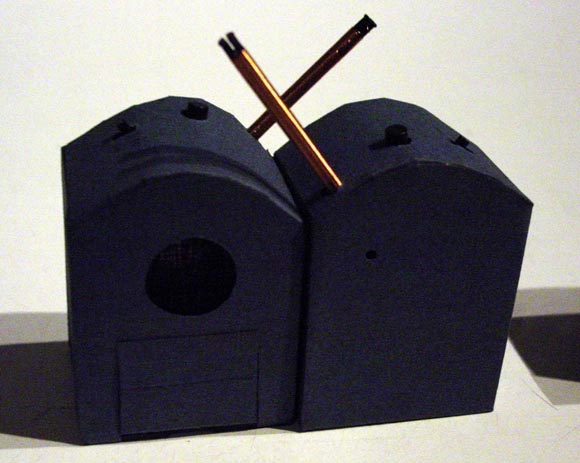
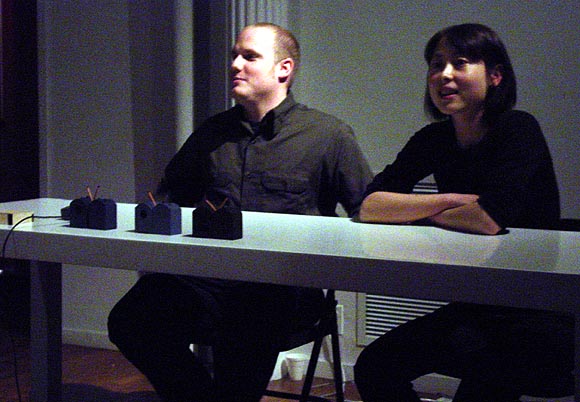
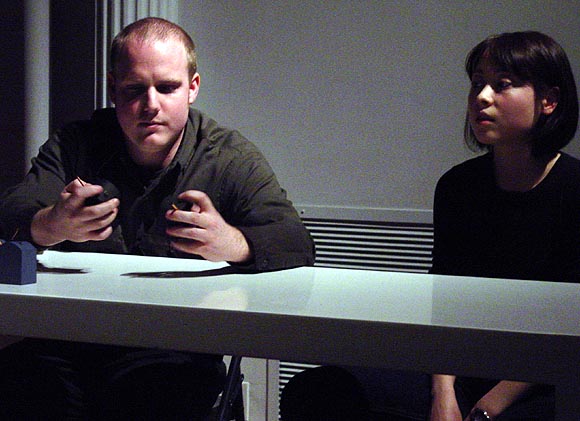
Neg-Fi's cassettes and art objects are available through La Superette, which is currently having a Valentines' Day sale. Also on the Dorkbot program tonight were Aaron Yassin, who digitally assembles plein air photos of architecture into seductive tiled patterns reminiscent of Islamic mosaics and Gothic stained glass, and Jason Freeman, who recently had a piece performed at Carnegie Hall in which an orchestra played notes based on the rate at which concertgoers turned on and off glow sticks. The somber 20th Century classical sounds made by the players, reading from a score digitally translating from the blinking lights, seemed even more sedate considering the stick-waving rave taking place in the audience.
UPDATE: The Neg-Fi photos have been brightened up. In true neg-fi spirit they lost some detail, but they are less dingy and yellow now.

Another work from Leif Ritchey's show at ATM. In the beginning was Pollock, and it was called "formalism," but yea that was ridiculous because everyone knew it was a wrenching experience beyond language and not some pedantic exploration of art's technical building blocks. Then Pollock begat Mike Kelley, who stole from women (in a good way) and imbued the formal language that was never formal with specific cultural referents: the soiled stuffed animals plucked from a thousand swap meets that were tokens of love and personal debt: "more love hours than could ever be repaid." And they were good. And Pollock and Kelley begat Leif Ritchey, who returned art to its own innate discourse, leaving it to the viewer to find strands of narrative meaning in his seamstress bricabrac accumulated, teased, and tortured almost beyond belief. And thence it was bequeathed to cyberspace...

Drawings of piezoelectrically stimulated barium titanate from Scientific American, June 1988, animated without permission.
Artist Bill Schwarz, who has a page here at Digital Media Tree, got into a cool online food fight yesterday with "design sponge"--a design blogger recently profiled in the New York Times. What is a "design blogger"? Reporter Lockhart Steele gives the flavor:
On design blogs, readers who are normally not privy to chatter among interior decorators and tastemakers can participate in debates on burning topics (sample: Is the designer Karim Rashid overrated?); get advance word on design trends, like erotic stained glass; and find answers to practical issues, such as how to quiet an obnoxiously loud apartment buzzer. These tips and tidbits are sometimes dispensed by bloggers who support themselves with day jobs within the design industry.it seems Design Sponge blogs enthusiastically about (among other things) products her boss, a PR company, also happens to be flacking. Steele or his editor erroneously reported that she doesn't disclose the relationship--apparently she does, if that makes you feel better about her online recommendations.* Crabby artist that he is, though, Schwarz questioned the feelgood aspect of the project, from his own perspective as a former industry insider:
i think what puts me off about design sponge is the unironic career driven fashion immersion vibe. i worked for bergdorfs for over ten years and got a pretty good inside look at the design and fashion world. but it left me with fashion damage. what puts me off most is the underpinning of planned obsolescence. that little something that makes people dump their two year old stuff for new stuff. i think we should be dealing with classic designs that last for the life of the product and a product that is well made (a harris tweed jacket for instance) should last close to the life time of its owner.The wordy, wordy responses to Schwarz from design sponge and a rabid reader never replied to this issue. The rabid reader focused with Clarence Darrow-like intensity on Schwarz's use of the word "smarmy" to describe Design Sponge (I'd just say "gushy"), whether he learned of Design Sponge from the Times or on his own, and whether his comment was design blog jealousy. Pretty hard for the latter to be the case when you're running an art blog consisting mostly of minimally or cryptically worded links, with a recurring focus on design, architecture, and arcane Americana, I'd say, but anything's possible.
*Sermon-in-a-footnote. We've heard a lot of blather on the political blogs lately about the need for a blogger code of ethics. You write on blogs about what you know and what you feel passionately about, which may just happen to include carefully insinuated strands of paid PR flackery. Readers have to be critical too, and know that a blog may be good for information or inspiration but not necessarily hard, peer-reviewed facts. When I was reBlogging at Eyebeam, I was a hair's breadth from posting a picture of a "street tagger"'s work before I realized he was a well-paid-by-the-industry, footwear-decorating hack. At least one other hoax I didn't catch. Trust nothing!
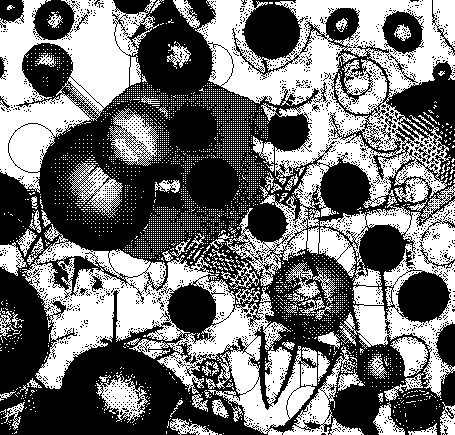
From daily Kos:
U.S. Encouraged by Vietnam Vote :
Officials Cite 83% Turnout Despite Vietcong Terror
by Peter Grose, Special to the New York Times, September 4, 1967
WASHINGTON, Sept. 3-- United States officials were surprised and heartened today at the size of turnout in South Vietnam's presidential election despite a Vietcong terrorist campaign to disrupt the voting.
According to reports from Saigon, 83 per cent of the 5.85 million registered voters cast their ballots yesterday. Many of them risked reprisals threatened by the Vietcong.
The size of the popular vote and the inability of the Vietcong to destroy the election machinery were the two salient facts in a preliminary assessment of the nation election based on the incomplete returns reaching here.
This interview with a comment spammer should be of interest to bloggers dealing with this online pestilence. In a nutshell, comment spam is legal but unscrupulous use of blogs' comment features to game search engines and drive up traffic to various vice and pharm-oriented websites.
["Sam"] uses the thousands of "open proxies" on the net. These are machines which, by accident (read: clueless sysadmins) or design (read: clueless managers) are set up so that anyone, anywhere, can access another website through them. Usually intended for internal use, so a company only needs one machine facing the net, they're actually hard to lock down completely. Sam's code gets hundreds of open proxies to obediently spam blogs and other sites with the messages he wants posted. They usually target comments to old posts, so they won't show up to people reading the latest ones, though search engine spiders will spot them and index them.The only foolproof solution (or at least the only solution "Sam" admits he dreads) is to install "captchas" on your site, such as randomly generated letters mangled in an imaging program that are readable by humans but not spambots, which would have to be typed in at the start of each comment.
